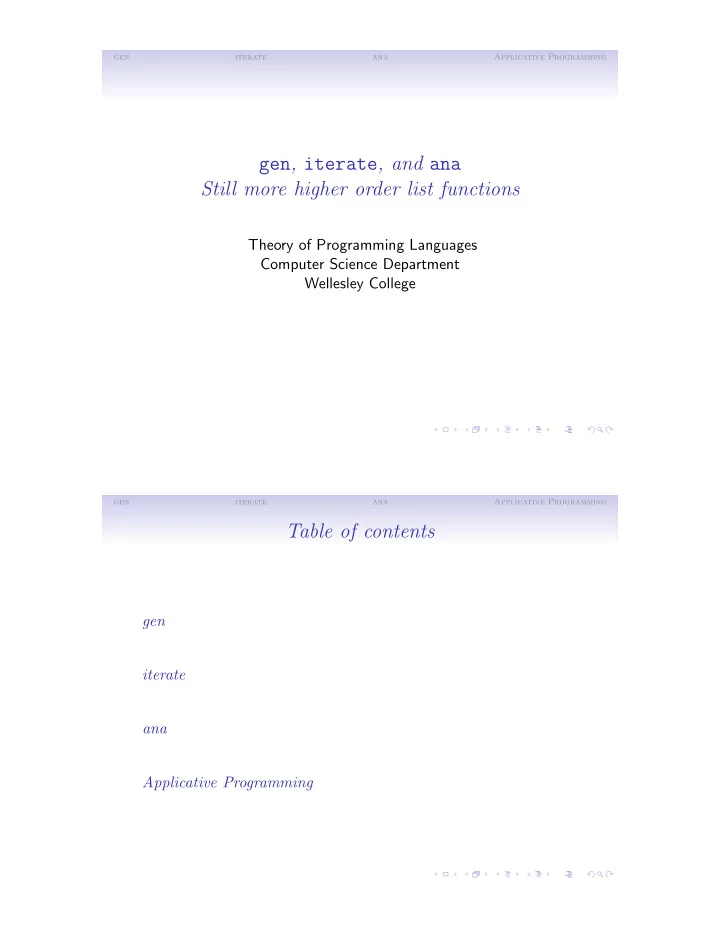

gen iterate ana Applicative Programming gen , iterate , and ana Still more higher order list functions Theory of Programming Languages Computer Science Department Wellesley College gen iterate ana Applicative Programming Table of contents gen iterate ana Applicative Programming
gen iterate ana Applicative Programming gen In addition to transforming and consuming lists, there are useful ab- stractions for producing lists. A handy abstraction for list generation is the following gen function: # let rec gen next isDone seed = if isDone seed then [] else seed :: (gen next isDone (next seed)) val gen : (’a -> ’a) -> (’a -> bool) -> ’a -> ’a list This function generates a sequence of values starting with an initial seed value, and uses the next function to generate the next value in the sequence from the current one. Generation continues until the isDone predicate is satisfied. gen iterate ana Applicative Programming gen in action Here are some sample uses of gen : # let range lo hi = gen ((+) 1) ((<) hi) lo ;; val range : int -> int -> int list = <fun> # range 7 14;; - : int list = [7; 8; 9; 10; 11; 12; 13; 14] # gen ((flip (/)) 2) ((=) 0) 100;; - : int list = [100; 50; 25; 12; 6; 3; 1] (* List.tl takes the tail of a list *) # gen List.tl ((=) []) [1;2;3;4;5];; - : int list list = [[1; 2; 3; 4; 5]; [2; 3; 4; 5]; [3; 4; 5]; [4; 5]; [5]]
gen iterate ana Applicative Programming gen viewed as an iteration abstraction The gen function can be viewed as an iteration abstraction that lists together all the intermediate states of an iteration. The next function indicates how to get from the current state to the next state, and the isDone function indicates when the iteration is done. # let fact_states n = gen (fun (n,a) -> (n-1,n*a)) (fun (n,a) -> n = 0) (n,1) val fact_states : int -> (int * int) list = <fun> # fact_states 5;; - : (int * int) list = [(5, 1); (4, 5); (3, 20); (2, 60); (1, 120)] # let fibsTo n = gen (fun (a,b) -> (b,a+b)) (fun (a,b) -> a > n) (0,1) val fibsTo : int -> (int * int) list = <fun> # fibsTo 5;; - : (int * int) list = [(0, 1); (1, 1); (1, 2); (2, 3); (3, 5)] gen iterate ana Applicative Programming iterate The following iterate function is similar to gen but only returns the final state of an iteration rather than a list of all states: let rec iterate next isDone state = if isDone state then state else iterate next isDone (next state)
gen iterate ana Applicative Programming Iteration For example: # let facti n = snd (iterate (fun (x,a) -> (x-1,x*a)) (fun (x,_) -> x = 0) (n,1)) val facti : int -> int = <fun> # facti 5;; - : int = 120 # let fibi n = match iterate (fun (i,a,b) -> (i+1,b,a+b)) (fun (i,_,_) -> i = n) (0,0,1) with (_,ans,_) -> ans;; val fibi : int -> int = <fun> # fibi 10;; - : int = 55 gen iterate ana Applicative Programming Anamorphisms We can generalize gen into a more flexible function known as an anamorphism: # let rec ana g seed = match g seed with None -> [] | Some(h,seed’) -> h:: ana g seed’ val ana : (’a -> (’b * ’a) option) -> ’a -> ’b list = <fun>
gen iterate ana Applicative Programming ana in action For example: let map’ f = ana (fun xs -> match xs with [] -> None | x::xs’ -> Some(f x, xs’)) let gen’ next isDone = ana (fun x -> if isDone x then None else Some(x, next x)) let fibsTo’ n = ana (fun (a,b) -> if a > n then None else Some(a, (b, a+b))) (0,1) In general, an anamorphism creates instances of a recursive datatype while a catamorphism accumulates results over instances of a recursive datatype. gen iterate ana Applicative Programming Applicative programming The style of programming illustrated in these slides is known as applicative programming. Applicative programs produce results by passing data structures through successive functional transformations. input d.s. d.s. d.s. result ✲ ✲ ✲ ✲ ✲ The classic example of a programming language designed to support this style of programming is APL (Applicative Programming Language): (2 = + � − 0 = r ◦ . 1 R ) / R ← in
Recommend
More recommend